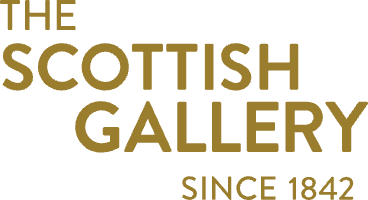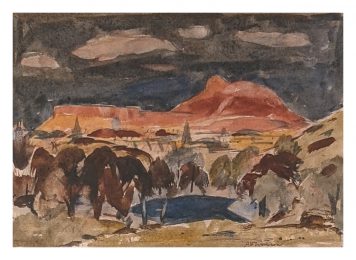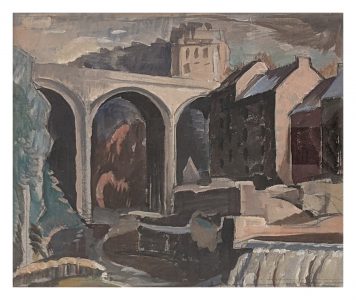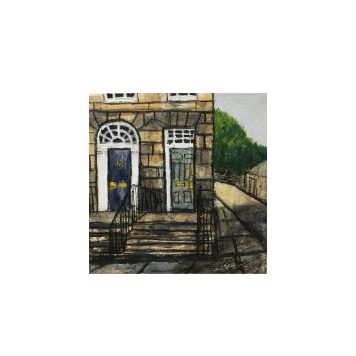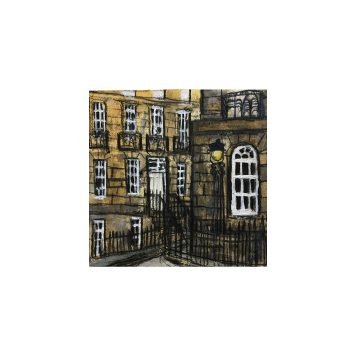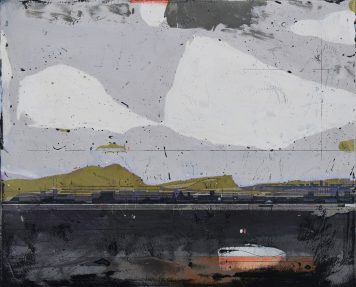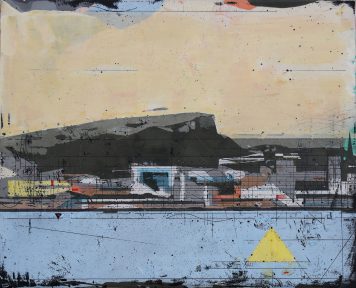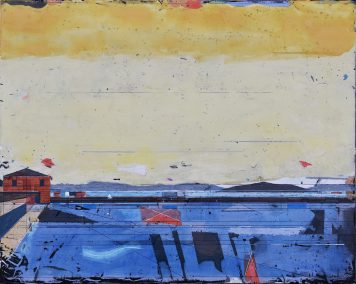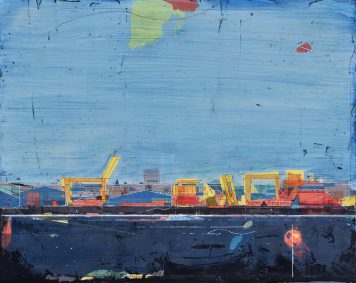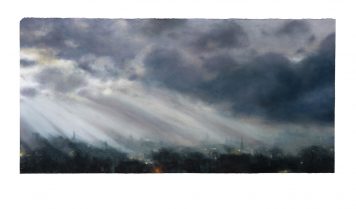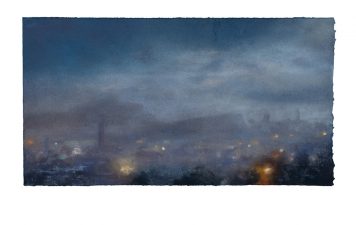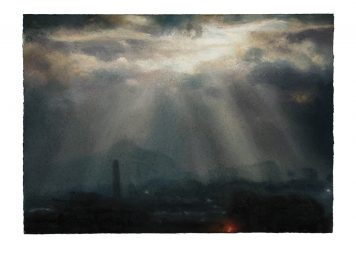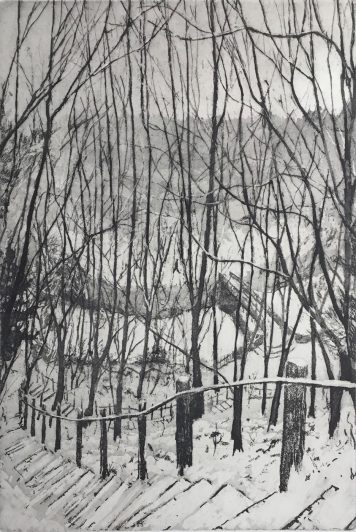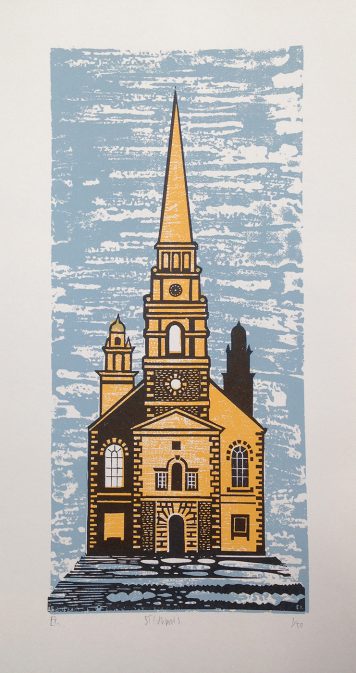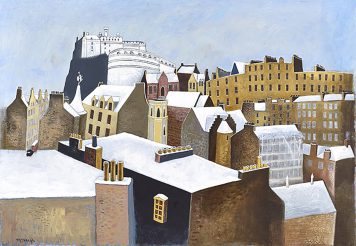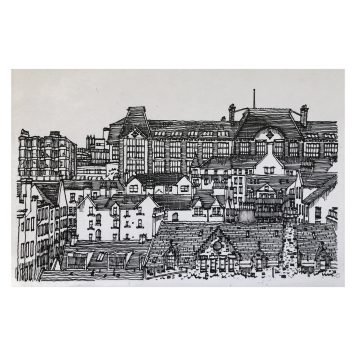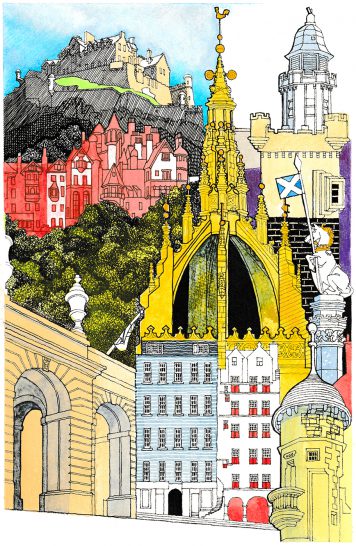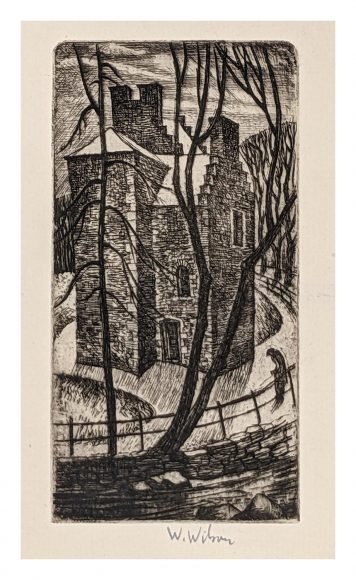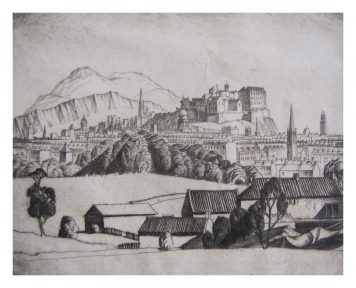Arthur’s Seat, Evening from the Burns Monument, c.1940
The Winter Commute – Saturday, 2014
It’s a Bitter Morning, Kitchen Window Series no. 83, 2021
St Cuthbert’s Church, Edinburgh
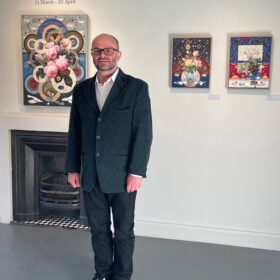
‘The essence of these works is setting up a direct conversation with an artist from a different age. Traces of humankind float through these images of nature.’ Colin Brown
Colin Brown is a fine artist and former graduate of Duncan of Jordanstone, Dundee who has lived and exhibited in Europe for several years. He is now based in Stonehaven in northeast Scotland. After graduating, a John Kinross Scholarship awarded by the Royal Scottish Academy enabled him to spend four months in Florence. In 1988 he established a studio in Glasgow, where he began practicing as a full-time artist. He also spent four years in Dusseldorf painting and exhibiting with several German galleries.
Colin Brown’s practice draws upon a range of media, particularly acrylic paint and collage. His work draws upon human histories, random and specific mark-making, urban imagery, and a mix of handwriting and printed script to explore the spirit of modern society. Brown has developed a strong international profile with regular solo and group exhibitions worldwide, including major solo shows in Hanover (1998), London (2010) and Singapore (2013). His work has received a number of awards, most notably an Artists Grant from the Pollock-Krasner Foundation, New York in 1996.

Bruce Thomson – or ‘Adam B’, as he was often called – was a painter of great integrity whose long, productive life tells the story of Scottish painting for the first three quarters the twentieth century. Thomson was born in 1885, attending first the Trustees Academy and then the newly established Edinburgh College of Art where he received diplomas in both Drawing and Painting, and Architecture before scholarships took him abroad to Spain and then Paris. He was an accomplished etcher and lithographer and he also sought expertise in the difficult media of pastel and watercolour. By the 1920s, his technique was closest to S.J. Peploe, Cadell and other contemporaries favouring the technique of painting on a gesso ground with an oil-reduced vehicle so the subjects tended to be treated in flat areas of colour.
Thomson served in the Great War before returning to the College where he taught etching, composition and still life to the painting school and colour theory to the architecture students. His association with Edinburgh College of Art continued until his death as, although he retired from teaching in 1950, he continued as an examiner and a Trustee. His links with both the RSA, where he was Treasurer for seven years and the RSW, where he served as President for a further seven years from 1957 were very important to him. He was awarded an OBE in 1963.
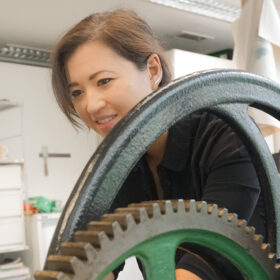
Kristina Chan graduated with Distinction in MA Print from the Royal College of Art London, trained in analogue and digital photography, lithography, etching, screen print, and digital media manipulation. Her work has been widely exhibited including Musée du Louvre, Royal Academy of Fine Art Antwerp, Royal Scottish Academy, and Idio Gallery.
Kristina was the 2017 recipient of the Elizabeth Greenshields Foundation Grant, winner of the Anthony Dawson RE Young Printmaker Award and RSA Guthrie Award for Outstanding Artist under 35 and a 2017 Wyng Media Award (WMA) Commission Finalist. Kristina received the Villiers David Travel Grant and award 2015, Canadian General Governor’s Award for Excellence 2010 and the Government of Canada’s Millennium Award and Bursary 2009.
‘My works are a culmination and accumulation into site specific history to depict socio-cultural entropic narratives. They explore the correlation between architecture and sculptural landscapes of derelict and disused spaces. I seek sites where the intersection between function and intention have fallen into decline and disrepair, where untold histories recount themselves, in all their brevity, satire, beauty, and collapse.
I work within the reimagined human landscape, looking back to see within: the immense intimacy of the world we shape to suit our needs and what happens when their obsolescence renders them irrelevant.’
Kristina Chan

Stephanie Dees was born in Northumberland, and raised in North Berwick before undertaking her formal art training at Edinburgh College of Art. She graduated with BA (Hons) in Drawing and Painting and an MFA in Painting, and she has been exhibiting at The Scottish Gallery since 1997.
Stephanie’s work portrays the transformative effect of light and season on both rural and urban landscapes. She uses mixed media, acrylic, watercolour, pencil, oil bar and oil pastel with quick expressive marks to convey the patterns and rhythms of Edinburgh’s New Town architecture. She sometimes uses pure watercolour to help her portray the translucency of a pale winter sky, or the reflective poignancy of a summer evening looking out to sea, when her subject shifts to the countryside in East Lothian or the Harbour Towns of the East Neuk.

Amy Dennis studied first at Leeds College of Art in the 1990s, later graduating in Drawing and Painting at Edinburgh College of Art in 2000. In 2018 she won the RSA William Littlejohn Award for excellence and innovation in water-based media. She was also the Jolomo Foundation Landscape painting award winner in 2013, and has exhibited with the Scottish Gallery since 2009.
Amy’s painting focuses on Edinburgh and the surrounding countryside, combining still-life motifs with landscapes based on close observation. Her simplified groups of objects reference drawing and measuring tools, which interact in the image with architectural details found on the sites. Her unique style involves a precise interweaving of line and composition, capturing landscapes with geometric precision to terrific effect.

Kate Downie was born in North Carolina but raised from the age of 7 in Scotland. She studied at Gray’s School of Art in Aberdeen before travel and residencies took her to the United States, England, Amsterdam, Paris and Japan. Her constant search for new challenges and inspirations has seen her set up studios in such diverse places as a brewery, an oil rig, and an abandoned Hydroponicum.
As a Landscape painter her subject matter is often the man-made rather than the natural, but it is defined by good draughtsmanship and a sense of movement.
‘One of my creative concerns is to define these spaces between buildings rather than the buildings themselves. The object lesson for me is the witnessing and the drawing of these nonplaces which are also, by definition, public arenas of cumulative activity. My job as an artist is to accommodate these actions in our contemporary lives, and to find the poetry within.’
– Kate Downie

Matthew Draper identifies himself principally as a draughtsman; drawing being the most unencumbered and immediate form of image-making. His work is made with an intense and energetic immediacy, working instinctively rather than methodically, keeping him physically and emotionally involved in the process. He crushes soft pastels in his hands, rubbing the dust into the paper in wide sweeps of colour, gradually manipulating the material to build up a thick layered surface using the ball of his thumb or the heel of his hand.
He is interested in and influenced by the dramatic imagery of eighteenth and nineteenth century painting. He admires the idea of the contemplation of landscape in the Romantic spirit, found in the work of the German Romantics like Caspar David Friedrich and the notion of the grandeur of the landscape as expressed in the work of the American subliminal painters like Sanford Robinson Gifford and Frederic Edwin Church. These artists adopted the term ‘Luminism’, defined as light in the landscape and the effect that light has on the landscape and objects within it.
As a contemporary artist choosing to adopt this approach to light in the landscape, his interest is not to make straight forward topographical images that are illustrations of place. Instead he is attempting to make imagery that is descriptive of the circumstances under which the subject is viewed; images which convey a sense of place. The drawings are emotional reactions to events and experiences evolving in front of him; events happening or about to happen. The images become like fading memories or captured moments in time. The making of the work is in itself a set of actions and events which creates a harmony between his process and his interpretation of the subject.

‘I have lived and worked as an artist in Scotland for almost 40 years. Although I work in several media my favorite is the artist print medium of etching. I like the mood and texture which I can get with the process: this is in landscapes or cityscapes. I am currently interested in etchings where I can explore how the medium can show light and mood. This may be the time of day or a season. I particularly like scenes which can be fully expressed in monotone. Winter scenes especially lend themselves to this where colour is often lost in the brightness of snow against the trees.
The traditional etching method is to draw through a wax layer on a metal plate which is then put into acid. The acid etches a line where a line has been drawn through the wax and so in this way the drawing is etched in metal. Once the wax is removed the plate has ink applied in the etched lines and paper placed over the plate and put through a press. As it is pressed down the paper picks up the ink from the groves and when peeled back shows the image on the paper.
The etched plate has the image in three dimensions where the etching has removed some of the metal and this gives the printed image its own unique texture. I always aspire to use this in the final image. For me etchings have a “punch” which the other print mediums cannot match and for this reason I return to it time and again.’
John Heywood
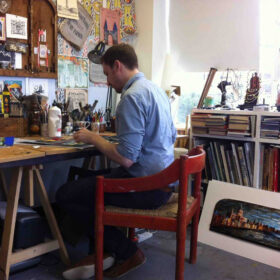
Ed Kluz, born in Suffolk, studied at Winchester School of Art. Ed is fascinated by the buildings, landscapes and objects of our cultural heritage. He seeks out the eccentric, the lost and the overlooked and in response creates works which re-examine and refresh our perception of the past.
Having made his home in Brighton, he has situated himself in a prime location for subject matter; surrounded by the decaying regency splendour that makes Brighton unique. At an early age he developed an interest in English Romanticism which remains at the core of his work.
As an artist and designer, he embraces many forms of image making, from printmaking and textile design to book illustration and paper collage.
Selected commissions:
Ben Pentreath Ltd; Faber & Faber; Little Toller Books; V&A; Fabric designs for St. Jude’s.

Michael McVeigh was born in 1957 in the post-war council estate of Lochee, Dundee located on the north west of the city, one of five children. He left school with no formal qualifications; however he wanted to be an artist and so began, unannounced, going to classes at Duncan of Jordanstone College of Art & Design, his presence being challenged eventually. James Morrison, then one of the lecturers, formalised his position and accepted him as a full-time student based only on his outstanding drawings and painting.
Since moving to Edinburgh in 1982 McVeigh became a familiar figure seen regularly working in the city and until a few years ago as a street artist. Life as a street artist brought a certain amount of unwanted celebrity status, especially in recent years, becoming a cult figure sought out by the city’s stag and hen parties, eventually having to limit tourists to ‘one photo only’.
Michael McVeigh is a modern day folk artist who depicts the world around him. He is a participant observer who has created a naïve and sophisticated setting for contemporary life and history. There is something of the medieval chronicler about him; he draws and paints what is there, and what is worth depicting because it is an essential, occasionally quirky, part of human existence.
His works are held in both public and private collections including town halls, pubs, fishmongers and a number of municipal and national institutions.

Gillian Murray was born in Perth, Scotland in 1970. She studied Fine Art (Printmaking) at Gray’s School of Art in Aberdeen, graduating in 1993.
After a move to Edinburgh she became an employee at Edinburgh Printmakers in 1996 until 2017. This involved working on print projects with a host of local, national and international artists as well as teaching courses in screenprinting and collagraphs. She now dedicates more time to creating her own artwork as well as freelance teaching and editioning.
She is a professional member of the SSA and has exhibited widely in Britain and abroad.
‘Over the years I have been making small trips mainly around Scotland & Europe, sketching and taking photos of the landscape and flora. Having collected my source information I create prints and watercolours inspired by the dramatic and beautiful views I have encountered.’
Gillian Murray

Arran is currently studying illustration at Camberwell College of Arts at UAL.
His work often revolves around the built environment and human influence in a cityscape. He finds it fascinating to compare the various cities he has visited in order to understand how they have developed to accommodate 21st century design.

From a young age Andrew was always interested in drawing and how we use lines to capture observed and imagined places. He studied architecture first in Plymouth and then at the Royal College of Art in the early 1990s where his interest in multi-disciplinary design practice grew whilst exploring a wide range of drawing methods before graduating into a digital world.
Andrew teaches drawing and design at Edinburgh College of Art and is a Teaching Fellow in Interior Design. He draws every day. For the last 5 years he has taken part in the global 100daysproject by drawing city scenes from direct observation and experience. He is also a regular member of the Edinburgh Urban Sketchers group when teaching allows.
His work is meticulous and detailed, capturing our city landscapes and interiors through rigorous and commited line and coloured drawing. His drawings bring a focus to how we see places and catalogue the everyday in a layered and techically rich way.
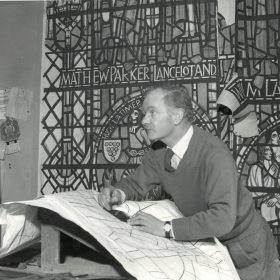
Click here to see prints by the artist.
Like many of the significant Scottish artists of the twentieth century, William Wilson was not satisfied with the restrictions of one medium, but focused his energies on three.
Throughout his life he fixed intently on each in turn; etching, watercolour painting and finally stained glass design, which obtained him an international reputation. However, it is his work in etching, made between 1925 and 1940 which is arguably his most powerful and successful work, and a unique contribution to Scottish art history. While the previous generation of Scottish etchers, DY Cameron and James McBey, had been primarily concerned with the documentation of landscape and atmospheric effect, Wilson’s interest lay in the structural qualities of an image, often realised through architectural subjects, relishing the angular juxtapositions of roof, wall and landscape. Wilson’s draughtsmanship is superb, his line as suggestive as Eric Gill and his tonality in a tradition that goes back to Samuel Palmer and Rembrandt. His etchings are visually rich, suffused with atmosphere and represent a body of work to match McBey and Cameron.
